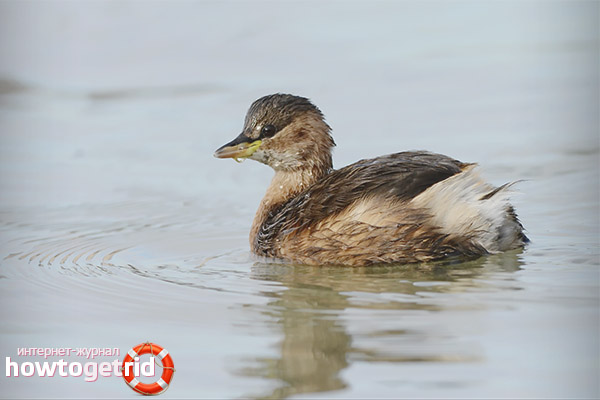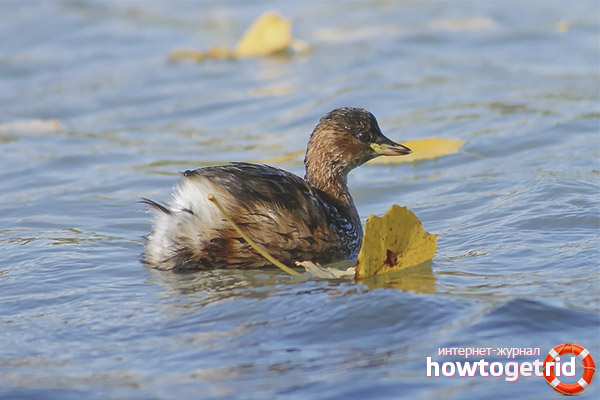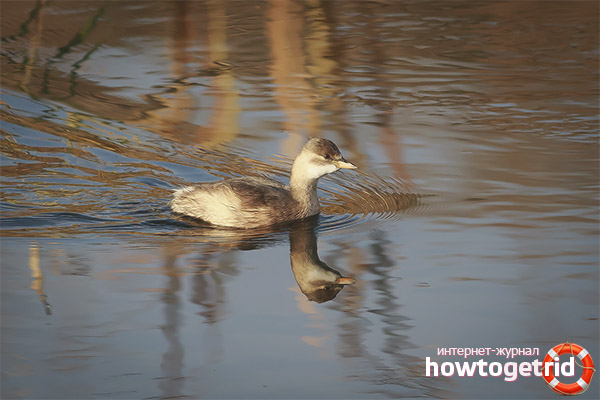The content of the article
Outwardly resembling a duck, the smallest of all members of the family is Malaya Poganka. A small bird has a short beak and a fairly rounded body, which during the mating season is distinguished by a motley color.
This waterfowl is distributed in various parts of the planet and is often an object for hunting.
Appearance
Lesser Poganka is inferior in size to the thrush. The wingspan of the bird is up to 450 mm, and the body length does not exceed 300 mm. Externally, the creation is quite compact and rounded, has a shortened neck.
The characteristic mantle plumage of the toadstool is red-chestnut tones (sides, cheeks, neck) and blackish-brown (back, stomach). It does not have feather ornaments on its head. In winter, the bird dresses in more plain and light brown shades (the bottom remains white). A small yellow spot at the base of the black beak is also characteristic of representatives (in the section of the mouth, the shade is yellow-green). The latter is also slightly up. On folded brown wings, a bright mirror can be noted. Hazel eyes are brown. The tail is practically absent.
Downy chicks are mostly black in color, with red longitudinal stripes remaining on the back, and white on the head and neck. The latter are observed in adolescents before the appearance of adult plumage. Beak in babies is bright pink.
Lifestyle
Lesser Grebe chooses moderately overgrown standing reservoirs and ponds for the settlement, where it prefers to remain inconspicuous and quiet. She often hides in thickets of reeds and other aquatic vegetation, organizing floating nests in the same place, using plant “waste” of water and muddy bottom.
After the mating season, adults and adolescents organize in small flocks and go wintering to the south. If the temperature is above zero (the water does not freeze), grebes can winter in the intermediate lane, for example, in large rivers, organizing wintering. Basically, the birds go to the coastal waters of the Crimea or southern freshwater bodies.
Small grebes feed on a variety of aquatic invertebrate representatives (snails, insects, etc.), local floating and underwater plants, but small fish occasionally come into the beak.
Unlike other representatives of the Poganok family, the small one quickly takes off and picks up speed, confidently floating low above the surface of the water. Less fearful is the bird on land, trying to awkwardly move on its paws, holding the body at a certain angle to the ground. Of their own free will, the toadstool rarely leaves the water surface and gets ashore, where various dangers lurk, in particular, hunters and predatory animals. In the water, the bird feels great, confidently swims and dives.
The voice of a small toadstool resembles a sonorous flute trill, the so-called "swirling" and twitter in high key. Hunters characterize the voice as “whit-whit”. Toadstool trills are often heard when she is worried about a nest. Periodically, these same sounds are heard during the mating season.
Breeding
Unlike other members of the family, the bird can rarely be found as a matrimonial boyfriend, demonstrating dancing readiness for mating. But during the formation of a pair between males, aggressive collisions are possible, which are manifested in 3 characteristic behavioral reactions.
- Attacking pose. Toadstool extends its neck straight and up, feathers on its head stand on end, the beak is lowered, and the back half of the body is randomly moving left and right. The similarity of the tail is upward.
- Menacing pose. In water, the male lowers its head and neck over the surface with the readiness to engage in a fight.
- Hunchback posture. The beak is down, the head is pulled in, the feathers are disheveled. Grebe raises wings above his back and twitches them. As a rule, this pose completes the demonstration of behavior, so the male makes it clear that the couple is created and the chosen female is his.
During the nesting period, grebes rarely show their voice, keep secretive and inconspicuous, protecting offspring. Clutches are made out in thickets, and on open water, and on sticking-out bushes, and on rafts. Near the main nest there are also several auxiliary “sites” of a temporary nature, where parents mate and rest.
After hatching, the chicks, like other members of the family, “ride” on the backs of their parents, hiding comfortably in their plumage. Feeding occurs by the "beak in beak" method. Gradually, young growth begins to try to sink into the water - independence comes in 1-1.5 months.
Habitat and Status
Small grebe unevenly lives in the center of Europe, Australia, South Asia and tropical regions of Africa. Widely distributed in Russia, namely in the south, as well as in the latitude of Moscow. A large concentration of birds was recorded on Lake Black, on a local small lake in the Koibal steppe. The passage of birds was also noted on the Yenisei River in the region of the Sayasno-Shushensky protected area. He likes to nest in Tuva and Khakassia, on the shores of the Black Sea.
The bird is quite secretive and rare, so it rarely catches the eye of ecologists and poachers. In recent years, the number of small grebe has a tendency to decrease. In addition, members of the family are extremely difficult to tolerate the harsh winters of the northern latitudes. That is why the bird urgently needs to protect the population at the state level.
Video: Little Grebe (Podiceps ruficollis)












Submit